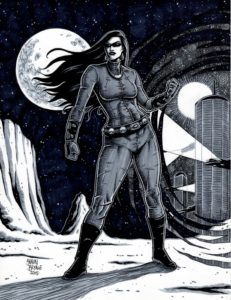A mixed-media art exhibit exploring the supernatural elements and beings of Indigenous stories through a modern superhero comic lens is coming to Open Space. When Raven Became Spider features work by six Indigenous artists: Joi Arcand, Shawn Beyale, Sonny Assu, Elle-Máijá Tailfeathers, Jeffrey Veregge, and Julianne Beaudin-Herney.
Curator Leena Minifie first designed the show for Dunlop Art Gallery, located within the Central Regina Public Library in downtown Regina.
“Regina has a huge Indigenous population, especially in the downtown core,” explains Minifie. “There’s a lack of representation visually.”
Jennifer Matotek—Dunlop Art Gallery’s director and co-author of the exhibit’s corresponding book—had been working to increase representation of Indigenous artists within the space when Minifie pitched the idea to her. The show took two years to put together and has toured for three and a half years. Exploring the connection between oral and visual culture, When Raven Became Spider expands on the relationship between these two mediums with a pop-culture context. Traditional stories are always represented in visual culture; artists use them to create totem poles, carvings, and regalia.
“The next oral [storyteller] that comes up is then able to refer to [the art] and explain, so it’s always interplaying and also informing each other,” says Minifie. “Through oral stories, through visual, through oral again… that’s how our culture has played out for thousands of years.”

While this style is a departure from traditional Indigenous art, pop culture and the superhero genre cannot be removed from our collective experience. All of the artists in the show grew up being influenced by comics and cartoons. It’s apropos that the questions the show now raises for its curator are also informed by our cultural climate. The titular character, the Raven, is a narcissistic trickster, portrayed by artist Sonny Assu as Spider-Man. If he came through today, Minifie could see the Raven as an Instagram influencer. Yet, in this age of hyperreality, this exhibit also confronts us with the question of balance.
“Raven has Eagle as a counterpart,” says Minifie. “Eagle is wise, quiet, and kind of more stoic… always chastising Raven for his ways. Part of me doing When Raven Became Spider made me realize I’ve left Eagle behind. Where is the room for Eagle in this world of overtalking and narcissism and fake news?”
Throughout the tour, the show takes on a different meaning based on the geographical and political landscape of the current city. In the prairies, with systems that are more male dominated, the work is read as very feminist; in Ontario, it’s seen as a statement on the crisis of missing and murdered Indigenous women. There’s no escaping the political nature of the work, whether or not the art was originally meant as a political statement.
“Being born Indigenous means being born political,” says Minifie. “There’s no way of avoiding that.”
Throughout her career, Minifie has been labeled “radical” as a way to dismiss her work. Now, with much of Canada catching up to her recognition of the unfair treatment and oppression of Indigenous people, that label may apply more aptly to the idea of comic-book art in art galleries.
“Mixing pop culture with Indigenous super beings [brings] levity and is also very family friendly, and I have no qualms about being what people call [a] ‘not high art show,’” Minifie says with a laugh. “I can be radical or not a high-art curator, there will always be something that keeps me on the outside, and that’s where the fun is… The liminal space is always more fascinating to me.”
When Raven Became Spider
Until Saturday, February 8
Free or by donation, Open Space
openspace.ca
